COVID-19 CT scan
For COVID-19 frequently asked inpatient questions, click here
For COVID-19 frequently asked outpatient questions, click here
|
COVID-19 Microchapters |
|
Diagnosis |
|---|
|
Treatment |
|
Case Studies |
|
COVID-19 CT scan On the Web |
|
American Roentgen Ray Society Images of COVID-19 CT scan |
Editor-In-Chief: C. Michael Gibson, M.S., M.D. [1]; Associate Editor(s)-in-Chief: Sabawoon Mirwais, M.B.B.S, M.D.[2] Syed Hassan A. Kazmi BSc, MD [3] Aditya Ganti M.B.B.S. [4] Nasrin Nikravangolsefid, MD-MPH [5]
Overview
Non-contrast Chest CT scan is an effective method for the rapid diagnosis of COVID-19 and monitoring the disease progression. Chest CT scan findings in patients infected with coronavirus can include unilateral or bilateral pneumonia, mottling and ground glass opacity, focal or multifocal opacities, consolidation, and septal thickening with subpleural and lower lobe involvement.
CT scan
- Non-contrast Chest CT scan is an effective method not only for the rapid diagnosis of COVID-19 but also for monitoring the disease progression. [1]
- Given the high sensitivity of chest CT, it can be used in suspected patients with negative RT-PCR. [2]
- Various chest CT features have been found diagnostic for COVID-19 that are associated with:
- Duration of illness
- Severity of illness
- Bilateral ground glass opacities ± consolidation in posterior and peripheral lung regions are considered as the hallmark for COVID-19. [3]
- However, there are a large number of typical and atypical chest CT findings for COVID-19 that are summarized in the figure below. [4] [5]
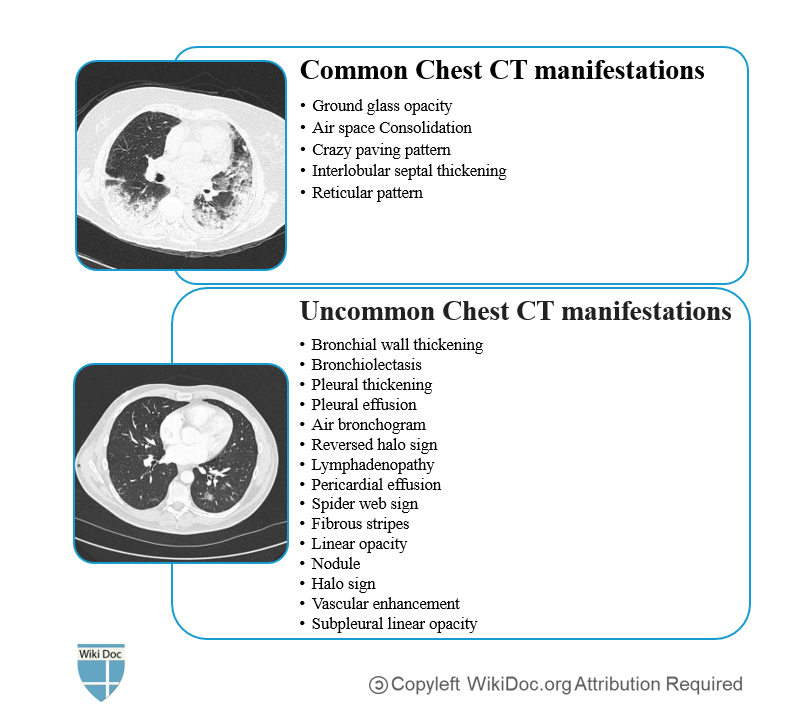
Key CT Findings in COVID-19
| CT manifestations of COVID-19 | |||
|---|---|---|---|
| CT findings | Definition | CT picture | |
| Ground glass opacity |
|
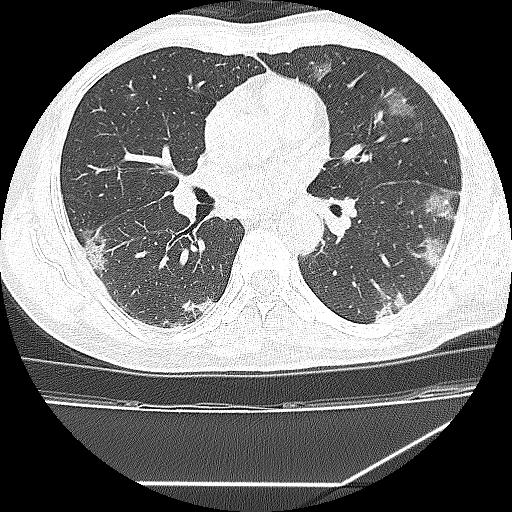 | |
| Consolidation |
|
||
| Crazy paving pattern |
|
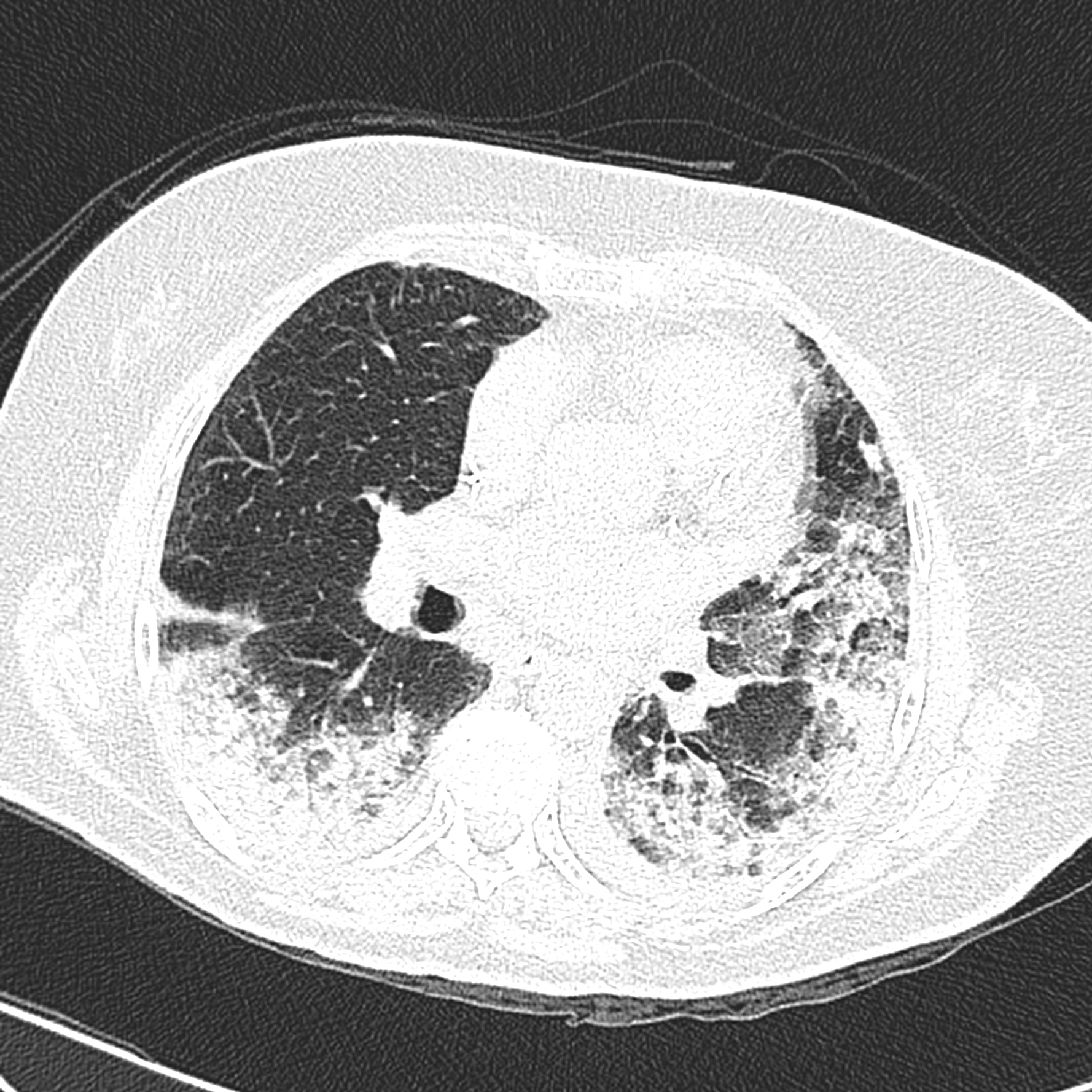
| |
| Reticuldar pattern |
|
||
| Air bronchogram |
|
||
| Bronchiectasis |
|
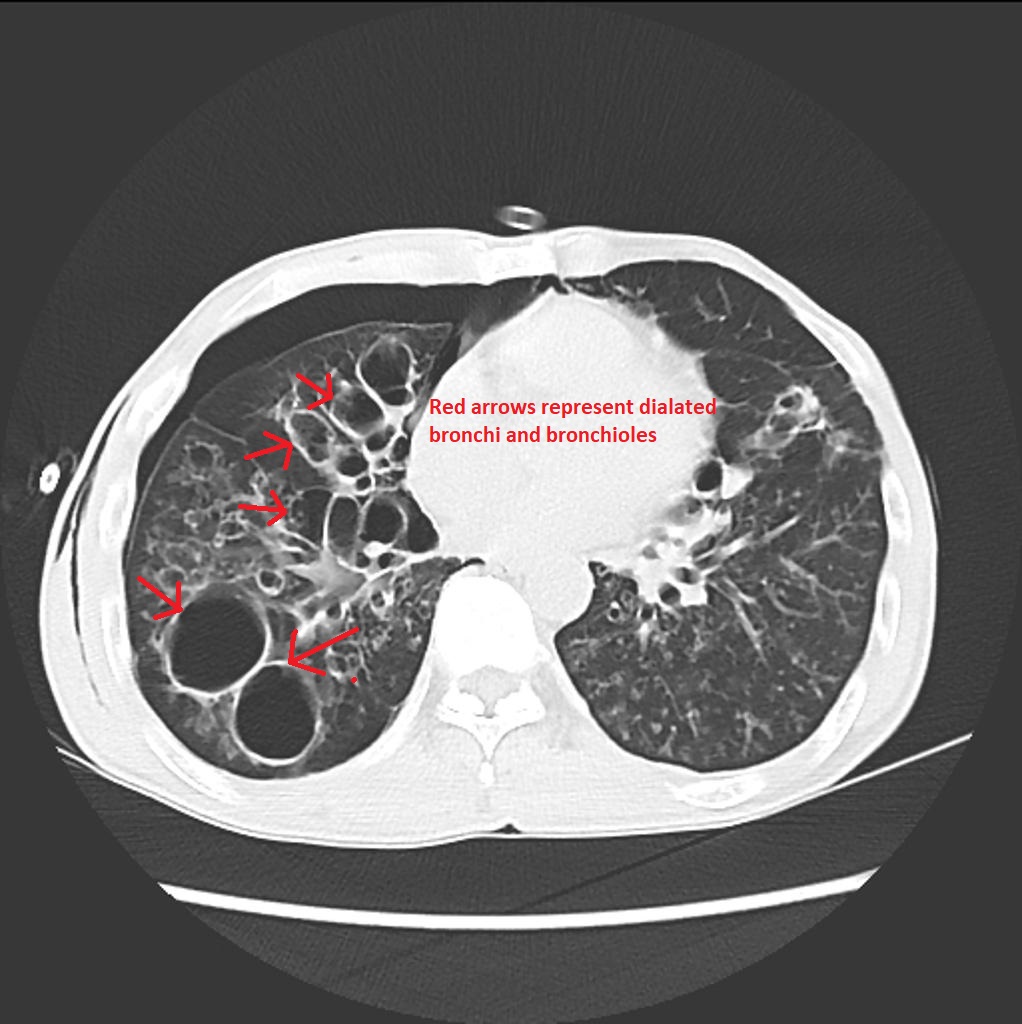 | |
| Pleural effusion |
|
 | |
- Time interval between onset of symptoms and chest CT manifestations is classified into 3 stages[6]:
- Early: between 0-2 days
- Intermediate: between 3-5 days
- Late: between 6-12 days
- Ground-glass opacities and consolidation are more likely to develop in the intermediate and late stages. [6]
- Linear opacities, crazy-paving pattern, and reverse halo sign usually develop during the late stages. [6]
- The presence of lymphadenopathy and pericardial effusion are associated with severe COVID-19 pneumonia. [4]
- chest CT manifestations are usually resolved within 14 days of symptoms onset. [9]
Radiological Society of North America
The Radiological Society of North America (RSNA) classified CT findings of COVID-19 infection into four categories which were endorsed by the Society of Thoracic Radiology and the American College of Radiology (ACR):
| RSNA CT findings classification of Covid-19[10] | |
|---|---|
| Typical appearance |
|
| Indeterminate appearance | Absence of typical CT findings and the presence of
|
| Atypical appearance | Absence of typical or indeterminate features and the presence of
|
| Negative for pneumonia | No CT features to suggest pneumonia, in particular, absent GGO and consolidation |
CT Examples of COVID-19
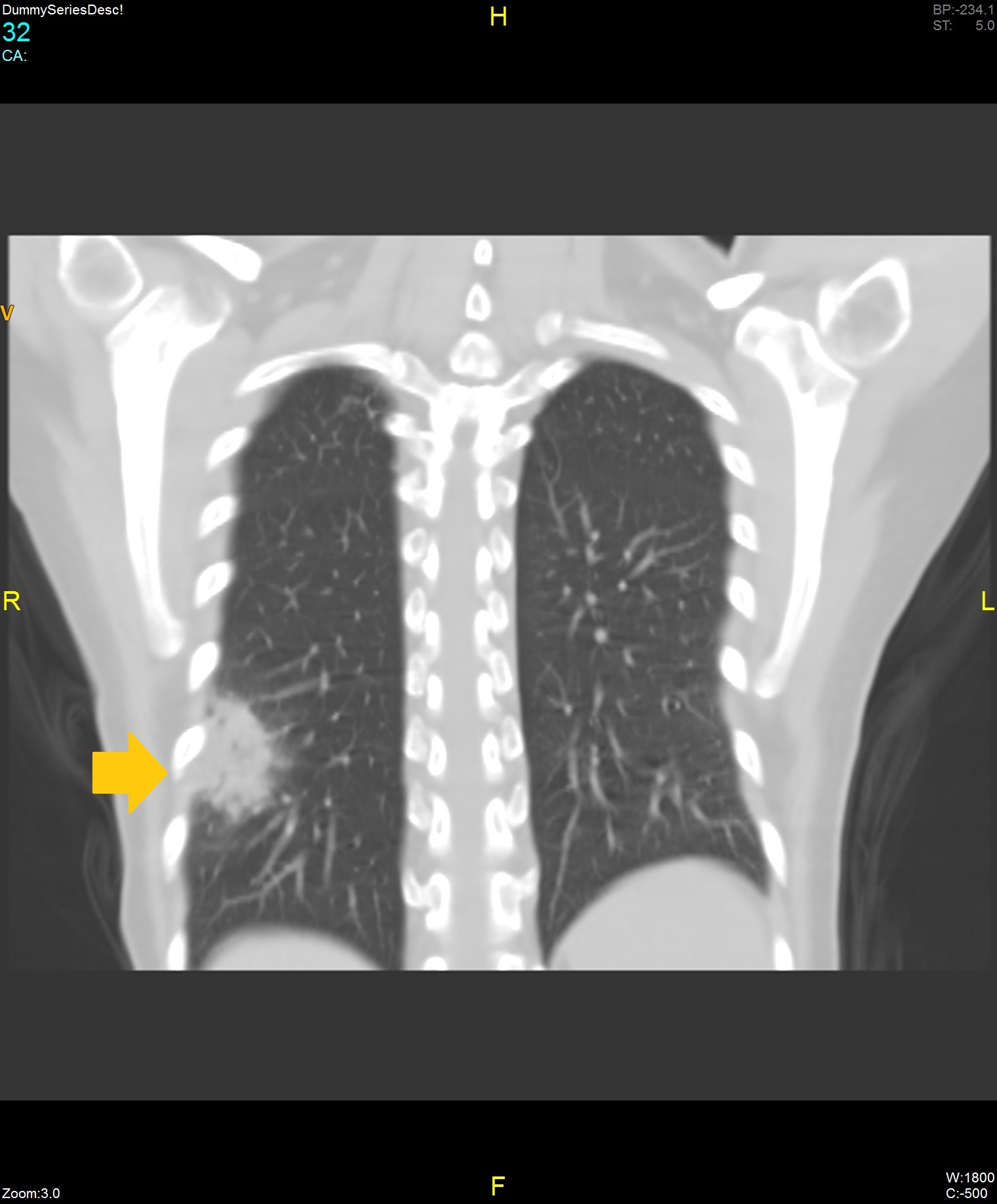
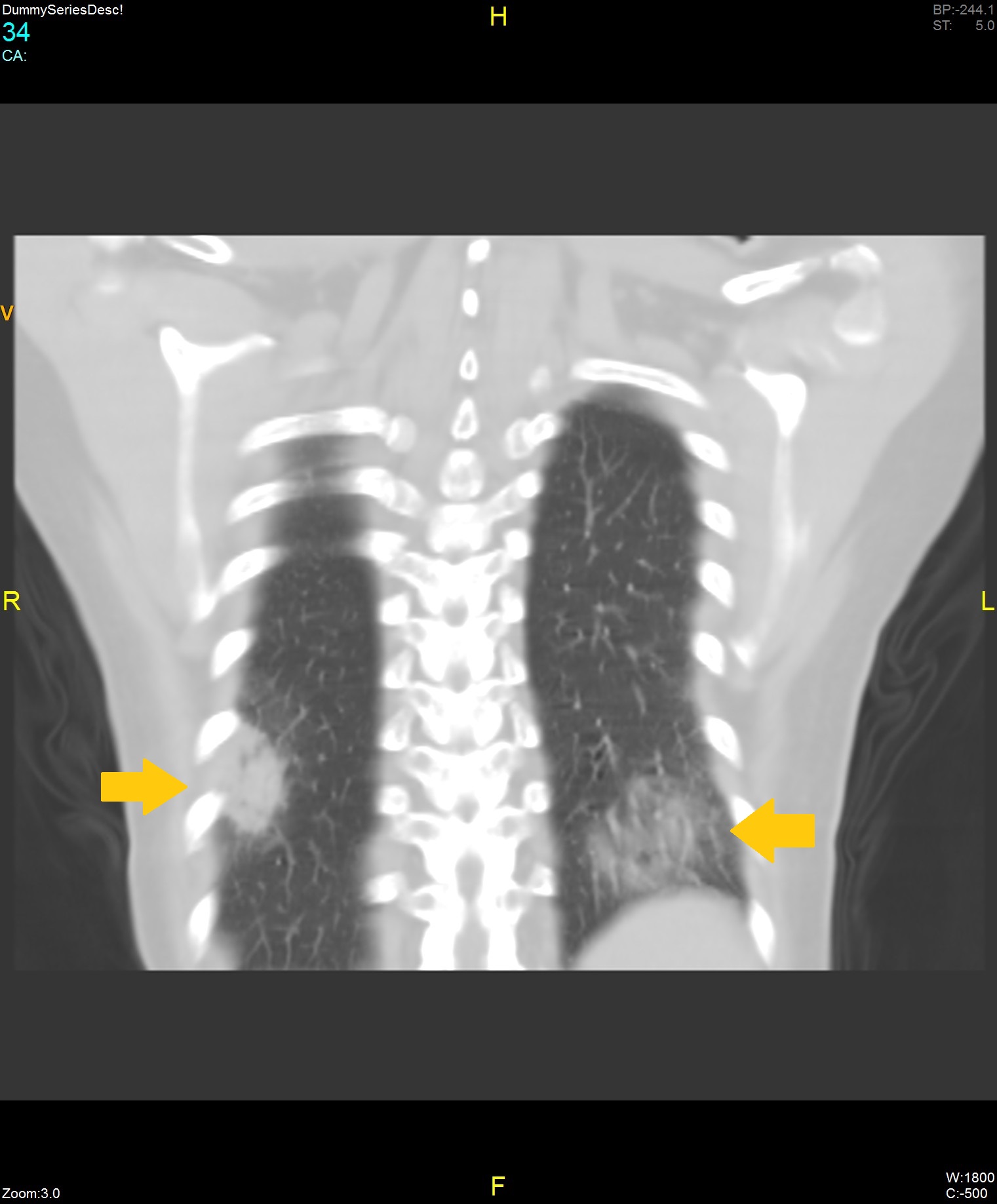


References
- ↑ Xu B, Xing Y, Peng J, Zheng Z, Tang W, Sun Y; et al. (2020). "Chest CT for detecting COVID-19: a systematic review and meta-analysis of diagnostic accuracy". Eur Radiol. doi:10.1007/s00330-020-06934-2. PMC 7227176 Check
|pmc=value (help). PMID 32415585 Check|pmid=value (help). - ↑ Fang Y, Zhang H, Xie J, Lin M, Ying L, Pang P; et al. (2020). "Sensitivity of Chest CT for COVID-19: Comparison to RT-PCR". Radiology: 200432. doi:10.1148/radiol.2020200432. PMC 7233365 Check
|pmc=value (help). PMID 32073353 Check|pmid=value (help). - ↑ Chung M, Bernheim A, Mei X, Zhang N, Huang M, Zeng X; et al. (2020). "CT Imaging Features of 2019 Novel Coronavirus (2019-nCoV)". Radiology. 295 (1): 202–207. doi:10.1148/radiol.2020200230. PMC 7194022 Check
|pmc=value (help). PMID 32017661 Check|pmid=value (help). - ↑ 4.0 4.1 4.2 Ye Z, Zhang Y, Wang Y, Huang Z, Song B (2020). "Chest CT manifestations of new coronavirus disease 2019 (COVID-19): a pictorial review". Eur Radiol. doi:10.1007/s00330-020-06801-0. PMC 7088323 Check
|pmc=value (help). PMID 32193638 Check|pmid=value (help). - ↑ Sun Z, Zhang N, Li Y, Xu X (2020). "A systematic review of chest imaging findings in COVID-19". Quant Imaging Med Surg. 10 (5): 1058–1079. doi:10.21037/qims-20-564. PMC 7242306 Check
|pmc=value (help). PMID 32489929 Check|pmid=value (help). - ↑ 6.0 6.1 6.2 6.3 6.4 Bernheim A, Mei X, Huang M, Yang Y, Fayad ZA, Zhang N; et al. (2020). "Chest CT Findings in Coronavirus Disease-19 (COVID-19): Relationship to Duration of Infection". Radiology. 295 (3): 200463. doi:10.1148/radiol.2020200463. PMC 7233369 Check
|pmc=value (help). PMID 32077789 Check|pmid=value (help). - ↑ Xu X, Yu C, Qu J, Zhang L, Jiang S, Huang D; et al. (2020). "Imaging and clinical features of patients with 2019 novel coronavirus SARS-CoV-2". Eur J Nucl Med Mol Imaging. 47 (5): 1275–1280. doi:10.1007/s00259-020-04735-9. PMC 7080117 Check
|pmc=value (help). PMID 32107577 Check|pmid=value (help). - ↑ Lei, Junqiang; Li, Junfeng; Li, Xun; Qi, Xiaolong (2020). "CT Imaging of the 2019 Novel Coronavirus (2019-nCoV) Pneumonia". Radiology: 200236. doi:10.1148/radiol.2020200236. ISSN 0033-8419.
- ↑ Pan, Feng; Ye, Tianhe; Sun, Peng; Gui, Shan; Liang, Bo; Li, Lingli; Zheng, Dandan; Wang, Jiazheng; Hesketh, Richard L.; Yang, Lian; Zheng, Chuansheng (2020). "Time Course of Lung Changes at Chest CT during Recovery from Coronavirus Disease 2019 (COVID-19)". Radiology. 295 (3): 715–721. doi:10.1148/radiol.2020200370. ISSN 0033-8419.
- ↑ Simpson, Scott; Kay, Fernando U.; Abbara, Suhny; Bhalla, Sanjeev; Chung, Jonathan H.; Chung, Michael; Henry, Travis S.; Kanne, Jeffrey P.; Kligerman, Seth; Ko, Jane P.; Litt, Harold (2020). "Radiological Society of North America Expert Consensus Statement on Reporting Chest CT Findings Related to COVID-19. Endorsed by the Society of Thoracic Radiology, the American College of Radiology, and RSNA". Radiology: Cardiothoracic Imaging. 2 (2): e200152. doi:10.1148/ryct.2020200152. ISSN 2638-6135.
- ↑ Case courtesy of Medico Assistente Dr. Chong Keng Sang, Sam, <a href="https://radiopaedia.org/">Radiopaedia.org</a>. From the case <a href="https://radiopaedia.org/cases/73890">rID: 73890</a>
- ↑ Case courtesy of Medico Assistente Dr. Chong Keng Sang, Sam, <a href="https://radiopaedia.org/">Radiopaedia.org</a>. From the case <a href="https://radiopaedia.org/cases/73890">rID: 73890</a>
- ↑ Case courtesy of Dr Antonio Rodrigues de Aguiar Neto, <a href="https://radiopaedia.org/">Radiopaedia.org</a>. From the case <a href="https://radiopaedia.org/cases/76921">rID: 76921</a>
- ↑ Case courtesy of Dr Bahman Rasuli, <a href="https://radiopaedia.org/">Radiopaedia.org</a>. From the case <a href="https://radiopaedia.org/cases/75768">rID: 75768</a>